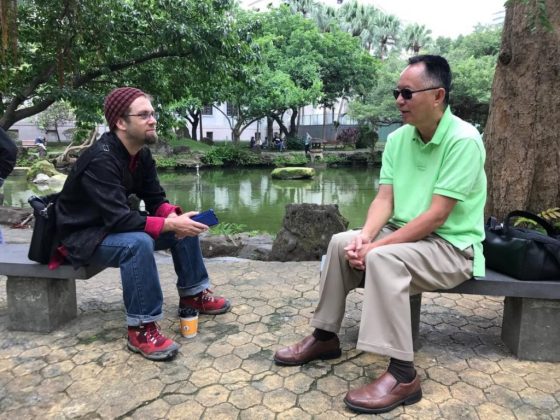Modern Taipei is a massive city overlaid by a spider web of intercrossing metro lines on which you can spend 90 minutes getting from one end of town to the other. But Old Taipei, which sprang alongside the eastern bank of the Danshui river, was a smaller place, and much of it fit neatly inside the confines of a city wall, among the last built in the waning days of the Qing dynasty.
Like the Qing dynasty, the wall itself is no more, but remnants of it (and its era) live on in Modern Taipei. This historical footprint of late 19th and early 20th century Taipei is especially well preserved in Dadaocheng.

Our exploration began on Dihua Street, which is best known as the place where Taipei-ren flock to in the weeks preceding the lunar new year festival to stock up on all manner of traditional – and often pricey – traditional Chinese foodstuffs, everything from dried seafood, and fish roe cakes to dried fruit and small handcrafted cakes. Think “fancy food you could travel and impress folks with in the days before refrigeration” and you’ve got the right idea. Area shopkeepers are used to tourists, and are known for having liberal sampling policies (growing especially generous in the weeks around Chinese New Year).
There are also apothecaries, tea shops, and all sorts of artist’s boutiques, most of which are set inside of buildings built during the Japanese colonial period. Our guide, Alex, has a knack for spotting interesting architectural features, and points out a few as we pass. On one building, an early 20th century builder wanted to incorporate a carved flower motif into the building’s stone, popular in the west at the time, but used instead an Asian melon in the place of the more traditional rose. (Read more: Shaping the Memories of a Century: Master Guo Gengfu’s Life of Mortar Shaping)

Dadaocheng is known for fabric. A multistory plaza in the center of the neighborhood, and to the north of this are a number of shops catering to those inclined to fiber arts. We visit one, a shop called InBlooom (like the Nirvana song, with an extra O), where we take a quick lesson in silk screen printing and come away with a few lovely gifts. The neighborhood is also known for tea, so a leisurely tea ceremony at South Street Delight – a Dadaocheng tea house mixing traditional and more modern presentation techniques – is also in order.

Rich in history though it is and was, one thing Dadaocheng was, was never within the city wall itself. The neighborhood stands today, as it did in the late Qing, north of the city’s northern gate (which still stands today, not far from Taipei Main Station), which would have placed it a good quarter mile outside of the wall’s dubious protection. But one of the first things the Japanese did upon taking control of Taiwan was to tear the wall down (an inefficient relic of bygone days, as they saw it) and use its bricks to expand the city. Dadaocheng was an important part of this expansion. Hence, many a brick from the old wall are likely woven into the fabric of the neighborhood, alive and serving a function to this day.
Click here to learn more about MyTaiwantour’s Vintage Taipei tour.
Read more to experience Dadaocheng :
The Old Taipei – Introducing the city’s Dadaocheng Area












